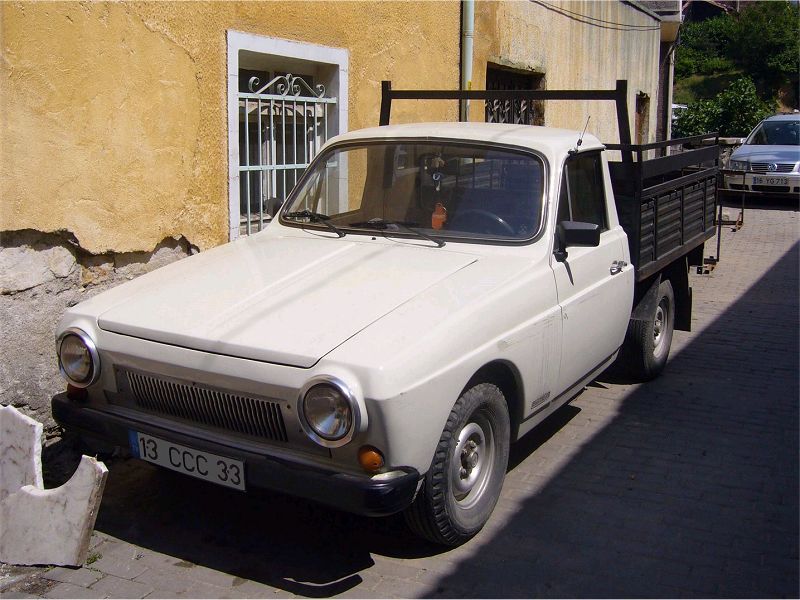The rumble of an engine through Istanbul’s streets in 1972 marked more than just another vehicle’s journey — it heralded Turkey’s bold entry into automotive manufacturing. The Anadol Pikap P2 500 emerged as a testament to the country’s industrial ambitions, combining British engineering expertise with Turkish manufacturing prowess.
This pickup didn’t just carry cargo; it carried the hopes of a nation stepping into the global automotive arena. While other countries had established their automotive legacies decades earlier, Turkey’s Anadol carved its own path, creating a unique blend of practicality and pioneering spirit.
The Pioneer of Turkish Automotive Industry
The dawn of the 1970s brought significant changes to Turkey’s industrial landscape. Anadol’s collaboration with British manufacturer Reliant resulted in a vehicle that would define a generation of Turkish transportation. The P2 500’s introduction in 1971 marked the beginning of a new era in Turkish automotive history.
The partnership between Turkish vision and British expertise proved transformative. Through careful engineering and local manufacturing capabilities, Anadol created a vehicle that met both domestic needs and international standards.
Historical Reference!
The Anadol Pikap P2 500's launch in 1971 represented the first mass-produced pickup truck from a Turkish manufacturer, setting a precedent for the country's automotive industry development.
Market response exceeded expectations, as businesses and private owners alike recognized the vehicle’s potential. The P2 500’s versatility made it equally suitable for urban deliveries and rural transportation.
Engineering Excellence Under the Hood
At the heart of the P2 500 beats a remarkably efficient 1298cc powerplant. This four-cylinder engine, featuring an 81.0mm bore and 63.0mm stroke, delivered reliable performance while maintaining reasonable fuel economy — a crucial consideration for its intended market.
The engine’s OHV (overhead valve) configuration represented a modern approach to valve control, while its 8.0:1 compression ratio struck an ideal balance between power and efficiency.
“The P2 500’s engine design was ahead of its time in terms of serviceability. Even today, these engines can be restored to perfect working condition with basic tools — a testament to their thoughtful engineering.” — Hassan Yilmaz, Classic Car Restoration Specialist
The powertrain could propel the 850kg vehicle to a respectable 120 km/h, adequate for both urban and highway use. This performance envelope perfectly matched the needs of its target market.
Design Philosophy and Practical Features
The P2 500’s dimensions reflect careful consideration of urban maneuverability and cargo capacity. With a width of 1645mm and height of 1440mm, it navigated city streets with ease while maintaining a commanding presence.
Interior upgrades focused on durability and comfort, addressing the needs of both commercial and private users. The cabin’s ergonomic layout prioritized functionality without sacrificing driver comfort.
Consider these key design elements that set the P2 500 apart:
- robust suspension system optimized for varied load conditions;
- thoughtfully positioned controls for effortless operation;
- practical cargo bed dimensions for maximum utility;
- aerodynamic profile reducing fuel consumption.
Fact!
The P2 500's body design incorporated advanced aerodynamic principles, achieving a drag coefficient that helped it maintain fuel efficiency even when fully loaded.
These features contributed to the vehicle’s reputation for reliability and practicality in diverse operating conditions.
Legacy and Collector’s Perspective
Today, the Anadol Pikap P2 500 commands respect in classic car circles. Its rarity — particularly well-preserved examples — has attracted increasing attention from collectors worldwide.
“What makes the P2 500 special is its historical significance combined with genuine utility. Every surviving example tells a story of Turkish industrial development.” — Marcus Thompson, International Classic Vehicle Appraiser
Recent market activities show growing interest in these vehicles. Original examples, particularly those with documented history, have seen steady appreciation in value.
The model’s influence extends beyond its production years, inspiring future generations of Turkish automotive designers and engineers.
A Heritage Worth Preserving
The Anadol Pikap P2 500 represents more than transportation — it embodies a pivotal moment in Turkish industrial history. Its legacy lives on through carefully preserved examples and the stories of those who relied on it.
For collectors and enthusiasts, the P2 500 offers a unique opportunity to own a piece of automotive history that bridges Eastern and Western engineering traditions.
| Pros | Cons |
|---|---|
| Historical significance as Turkey’s first domestic pickup | Limited top speed compared to contemporary vehicles |
| Robust and serviceable 1298cc engine | Spare parts scarcity in modern market |
| Practical dimensions for urban use | Basic interior amenities by today’s standards |
| Growing collector value | Rust-prone in certain areas |
| Simple mechanical design enabling easy maintenance | Limited production numbers affecting availability |
| Strong community support among classic car enthusiasts | Requires specialized knowledge for proper restoration |
| Cultural importance in Turkish automotive history | Original documentation often missing |
The Anadol Pikap P2 500 stands as a testament to Turkish industrial ambition and engineering capability. While it may not match modern vehicles in performance or comfort, its historical significance and increasing rarity make it a compelling choice for collectors and enthusiasts alike. As surviving examples become increasingly scarce, its position in automotive history only grows more secure.

